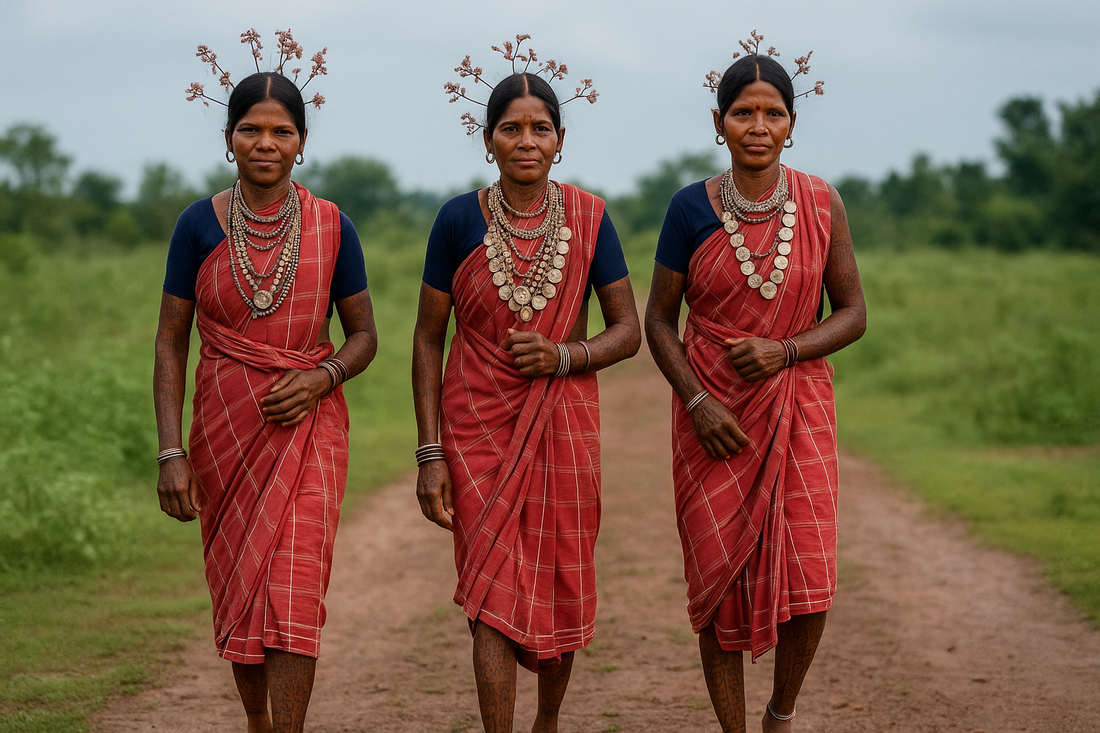
The Baiga Tribe — Forest Dwellers of Wisdom and Struggle
Share
Who Are the Baigas?
The Baigas are one of India’s oldest and most fascinating forest-dwelling tribes, primarily found in Madhya Pradesh, Chhattisgarh, and parts of Uttar Pradesh. Officially recognized as a Particularly Vulnerable Tribal Group (PVTG), the Baigas have lived for generations in deep forest areas, often in isolation, with customs and ways of life remarkably different from the outside world.
Their identity is deeply rooted in nature. They consider the earth sacred and do not plough it with metal tools, believing that it would be disrespectful to harm the mother who provides them food. Their livelihood traditionally revolved around shifting cultivation (bewar), forest produce gathering, and the use of medicinal herbs. They see the forest not as a resource to be exploited, but as a living, breathing home.
A Life Guided by Nature and Spirit
The Baigas believe in the spiritual essence of every element in nature. Trees, rivers, animals — all have consciousness. They practice nature worship and animism, and their festivals are simple, seasonal, and full of ritualistic respect for the land.
Their healers are revered not just for treating wounds or illnesses, but for knowing the right time to harvest a plant, the proper way to use roots, and the balance needed between taking from and giving to the forest. This isn’t folk medicine — it’s a form of indigenous science passed down orally for centuries.
The tattooing tradition of Baiga women, especially, is unique. Each tattoo has symbolic meaning, connected to beliefs around fertility, protection, and spiritual purity. Their jewelry, their songs, even the layout of their homes — everything tells a story about their bond with the earth.
The Baigas live communally. Elders are respected. Decisions are often made collectively. There is no formal education in many villages, but there is deep ecological knowledge that modern systems have yet to understand or value.
Language and Oral Traditions
The Baiga language is a dialect of the Indo-Aryan language group and is primarily oral. With limited written literature, stories, spiritual beliefs, herbal knowledge, and cultural practices are passed down verbally. Songs and folktales often serve as both entertainment and education — preserving everything from marriage customs to harvest techniques.
Due to increasing exposure to mainstream culture, the younger generation is slowly losing fluency in their native tongue. Language erosion threatens not just communication, but the very structure of their cultural identity.
Food and Lifestyle
The Baiga diet is primarily seasonal and sourced directly from the forest. Wild fruits, tubers, honey, minor millets, and occasionally fish or small game form the base of their meals. With increasing deforestation and loss of land rights, however, their access to traditional food sources has been severely reduced.
Today, many Baiga communities suffer from malnutrition, especially among women and children, due to restricted access to both forests and modern nutrition support.
The Art of Godna (Traditional Tattooing)

Among the Baiga women, the ancient art of Godna is more than a form of body decoration — it is spiritual, cultural, and symbolic. These intricate tattoos are etched onto the skin at different stages of life, each with unique meanings tied to identity, strength, protection, and community.
The process is deeply traditional and done by hand. The tattoo is applied using a mixture of soot or ash and cow urine or mother’s milk, pricked into the skin using a sharp instrument like a needle or thorn. There is no anesthesia — the pain is endured with stoic pride, often seen as a rite of passage.
Each tattoo placement holds significance:
- Forearms and legs reflect physical strength.
- Forehead markings symbolize wisdom and maturity.
- Back and chest designs offer protection from evil spirits.
In many Baiga communities, tattoos are considered essential — a woman without Godna is not considered fully Baiga. Despite growing pressure to abandon the tradition, many elder women still carry these marks with pride, acting as living canvases of tribal heritage.
The decline in Godna among younger generations reflects deeper shifts in tribal identity. Cultural preservation groups are now documenting and teaching these symbols to ensure they are not lost.
Baiga Art and Craftsmanship
Though less commercialized than other tribal arts, Baiga artistic expression is powerful in its simplicity and meaning. Most of their creative output is directly tied to utility or ritual:
- Wood carving is used in tools, musical instruments, and symbolic totems.
- Mud wall paintings are done using natural colors during festivals and seasonal changes — especially around harvest.
- Embroidery and beaded jewelry, while modest, showcase their sense of symmetry and pattern.
- Dances and songs often act as visual and oral expressions of seasonal shifts, spiritual beliefs, or shared history.
Art for the Baigas is not separate from life. It is embedded in their daily rhythms, rituals, and environments. Though they have received little attention in mainstream tribal art markets, their work represents a quieter, more grounded aesthetic — rooted in balance with the earth.
Many art historians argue that tribal art forms like those of the Baigas should be documented not only for cultural preservation but also for their inherent ecological wisdom — reminding us that sustainability can also be beautiful.
Gender and Roles
Baiga women play a central role in cultural preservation. They are custodians of traditional tattooing (Godna), seed saving, herbal medicine, and home-based rituals. Despite this, they face additional challenges when it comes to access to healthcare, education, and representation in decision-making bodies.
Efforts to empower Baiga women through self-help groups and organic farming cooperatives have begun in small numbers — but significant support is still needed.
Climate and Conservation

The Baiga lifestyle is inherently sustainable. Their shifting cultivation method, when practiced traditionally, allowed the forest to regenerate and maintained ecological balance. However, due to misconceptions and lack of adaptive policies, many of these sustainable practices have been restricted or banned.
Ironically, the very communities who have lived in balance with the forest for centuries are now seen as obstacles in conservation — when in fact, they could be its greatest protectors if properly supported and included.
The Book That Told Their Story
In the early 20th century, Verrier Elwin, a British-born anthropologist who later became an Indian citizen, lived among the Baigas and wrote the now-famous book "The Baiga" (1939). He documented their wisdom, rituals, and way of life in great detail.
Elwin was struck by the Baigas’ quiet dignity, their reverence for life, and their resistance to exploitation. He warned even then that unless society learned to respect their ways, modernity would push them to the margins — erasing not just their culture, but a valuable way of seeing the world.
You can read Elwin’s original book here: The Baiga by Verrier Elwin – Internet Archive
What Modernization Has Done
Elwin’s warning came true.
Over the past few decades, the Baigas have faced enormous cultural and economic pressure due to rapid development, deforestation, and administrative neglect:
- Deforestation and displacement: Many Baiga families have been displaced from their ancestral lands due to mining, dams, and development projects. The forests they once called home are shrinking.
- Loss of traditional knowledge: As younger Baigas are pulled into wage labor and urban migration, their connection to herbal knowledge, rituals, and oral history is fading.
- Lack of access to health and education: Despite being recognized as a PVTG, basic facilities are often missing in Baiga villages — healthcare is scarce, schools underfunded, and infrastructure almost nonexistent.
- Cultural dilution: Government assimilation policies, migration, and media exposure have slowly eroded their distinct identity. The pressure to conform to "mainstream" life often comes at the cost of their own heritage.
- Economic vulnerability: With little formal education or land ownership, Baigas often end up doing low-paying, unstable labor — far from the forests they once thrived in.
A Heritage at Risk
What’s at risk is not just a community, but a worldview. The Baigas represent a living example of sustainability, of living with — not over — the earth. Their knowledge of medicinal plants, water conservation, and ecological balance is priceless in a time of environmental crisis.
Yet, they remain invisible to most of the world.
Their story is not just one of hardship. It’s one of resilience. Of wisdom. And of the urgent need to listen, learn, and protect before it’s too late.
Further Reading
- 📚 The Baiga by Verrier Elwin (1939) – Full Book
- 📄 Baiga Tribe: Overview & Development Profile (Ministry of Tribal Affairs, Govt of India)
- 📰 Baiga Tribe and Forest Rights – Down To Earth
- 📖 Baiga Tattoo Traditions – INTACH Intangible Cultural Heritage
- 🧪 Medicinal Plants and Traditional Knowledge of Baiga Tribes—Indian Journal of Traditional Knowledge (IJTK)



 https://ayurvance.com
https://ayurvance.com